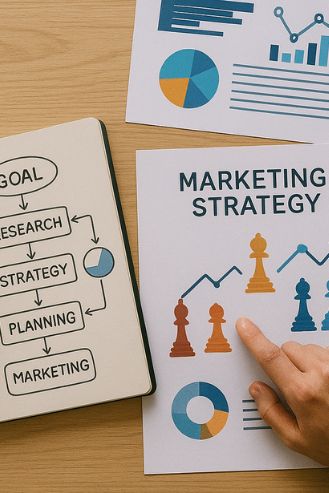
How to Build a Marketing Strategy: Step-by-Step Guide to Success
Marketing strategy is the blueprint that aligns your product, audience, and channels to drive sustained growth—not just short-term spikes. A strong strategy clarifies who you serve, why you win, and how you will allocate resources to consistently acquire, engage, and retain customers. Instead of random acts of marketing, a well-built plan translates business goals into measurable programs across the entire funnel. In this guide, you’ll learn a practical, repeatable process for building a marketing strategy from the ground up, whether you’re a startup founder, a solo marketer, or part of a scaling team.
Before diving into tactics, anchor your approach in first principles: clear objectives, deep audience understanding, a sharp value proposition, and a channel mix you can execute well. If you want a quick primer on what effective plans look like, this overview of effective marketing strategies is a helpful reference. Remember, your marketing strategy is a living system—built on customer insight, refined through testing, and measured relentlessly.

1) Translate Business Goals into Marketing Objectives
Start with the business model and revenue targets. Convert annual goals into marketing objectives using the SMART framework (Specific, Measurable, Achievable, Relevant, Time-bound). Examples include: “Acquire 1,500 qualified trials per quarter at ≤$75 CAC,” or “Grow email subscribers by 40% in six months with a 25% MQL-to-SQL conversion.” Tie each objective to a stage of the funnel (Awareness, Consideration, Conversion, Retention, Advocacy) so you can design programs that move customers forward.
2) Research Your Market, Audience, and Demand
Do customer interviews, analyze search trends, review support tickets, and mine CRM notes to identify pains, triggers, and buying jobs. Quantify market segments, then build personas that include contexts (use-cases), objections, decision criteria, and preferred channels. Modern teams also use data products—intent signals, cohort analysis, and propensity models—to prioritize opportunities; for a deeper perspective on how analytics and automation shape planning, explore the role of AI in marketing intelligence and how it sharpens segmentation, messaging, and media mix decisions.
3) Clarify Your Positioning and Value Proposition
Positioning explains the unique value you deliver for a chosen audience versus alternatives. Craft a crisp positioning statement: “For [audience], who [need], our [product] is a [category] that [benefit], unlike [alternatives], we [differentiator].” Your value proposition should be testable—expressed as tangible outcomes (e.g., “ship 30% faster,” “cut onboarding time by 50%,” “increase pipeline quality by 2×”). Align claims with proof: case studies, quantified ROI, demos, benchmarks, and third-party reviews.
4) Build Messaging Pillars and Proof
Distill your story into 3–5 pillars that map to buyer pains and use-cases. For each pillar, define: primary message, two supporting claims, proof points (metrics, quotes, features), and content formats (one-pagers, webinars, comparison pages). Ensure consistency across website, ads, emails, sales decks, and onboarding flows. Good messaging reduces friction, increases confidence, and improves conversion across the journey.
5) Choose a Channel Mix You Can Actually Execute
Use the PESO model (Paid, Earned, Shared, Owned) to design a diversified, compounding mix:
- Owned: Website, blog, email newsletter, community, documentation. Highest long-term ROI; prioritize SEO, UX, and conversion rate optimization (CRO).
- Shared: Social platforms, communities, and partnerships. Focus on value-led engagement rather than volume.
- Earned: PR, influencer mentions, analyst coverage, reviews. Build credibility and authority.
- Paid: Search, social, programmatic, sponsorships. Use where target intent or precise targeting is available and economics are proven.
6) Design a Full-Funnel Content Strategy
Map core topics to each funnel stage. Top-of-funnel (TOFU) content should answer questions, frame problems, and earn attention. Middle-of-funnel (MOFU) content compares approaches, showcases use-cases, and quantifies outcomes. Bottom-of-funnel (BOFU) content reduces risk with demos, trials, calculators, and ROI proofs. Turn each flagship asset into a content atom bank (clips, quotes, snippets) to distribute across channels. Optimize for search intent, readability, and on-page conversion. Maintain content briefs with target keyword, searcher intent, outline, internal links, and success metrics.
7) Plan Offers, CTAs, and Conversion Paths
Every asset should have a next step: subscribe, download, book a call, start a trial, join a webinar. Align offers with visitor readiness; don’t push a demo to a first-time visitor who needs a comparison guide. Use dedicated landing pages with singular CTAs, social proof, and objection handling. Test variants methodically—headline, hero image, risk reversal, form fields, and trust badges—using statistical thresholds to avoid noisy conclusions.
8) Budget, Forecasts, and Unit Economics
Translate objectives into volume, conversion, and spend assumptions. Build a bottom-up plan: impressions → clicks → leads → MQLs → SQLs → opportunities → customers. Model CAC by channel and lifetime value (LTV) by segment to ensure payback within your horizon (e.g., 6–12 months). Allocate 70% to proven programs, 20% to new bets, and 10% to experiments. Create guardrails (max CAC, min conversion rate) and escalation triggers.
9) Lifecycle and Retention Strategy
Growth compounds when you retain and expand customers. Map lifecycle plays across onboarding, activation, adoption, expansion, and advocacy. Use behavior-based messaging (product usage, support events, billing milestones) and in-app guides. Build customer marketing: case studies, user groups, roadmaps, and referral programs. Retention insights should feed back into acquisition messaging and ICP focus.
10) Measurement: KPIs, Dashboards, and Feedback Loops
Define a small set of North Star and supporting metrics: pipeline created, CAC payback, LTV/CAC, conversion by stage, win rate, retention, and NPS/CSAT. Instrument analytics end-to-end: UTMs, call tracking, CRM hygiene, and clear attribution logic (last-touch vs. data-driven vs. lift studies). Build weekly and monthly operating reviews to diagnose what’s working, what’s not, and where to reallocate budget.
11) Run Experiments Systematically
Treat experimentation as product development for your go-to-market. Maintain an ideas backlog with hypotheses, estimated impact, effort, and confidence. Prioritize with ICE (Impact, Confidence, Ease) or PIE. Document each test’s setup, sample size calculation, and stop rules. Share results and learnings in a central repository so the team compounds knowledge over time.
12) Align the Team and Clarify Operating Rhythm
Clarify swimlanes for product marketing, demand gen, content, brand, lifecycle, and partner marketing, plus the interfaces with sales, product, and success. Establish cadences: weekly standups, monthly reviews, quarterly planning. Maintain a single source of truth—a roadmap and scorecard everyone can see—and define how decisions are made (e.g., DRI model).
Practical Templates You Can Adapt
- Strategy one-pager: Audience, pains, value prop, goals, channel mix, and key bets.
- Persona brief: Profile, goals, objections, triggers, preferred channels, top tasks, and messages.
- Content brief: Target keyword, intent, outline, internal links, CTA, expected outcome.
- Experiment doc: Hypothesis, metric, variant, sample size, duration, result, decision.
- Dashboard spec: Metrics, source of truth, owners, review cadence, and alerts.
Common Mistakes to Avoid
- Confusing tactics with strategy: Running ads is not a strategy; it’s one lever in a broader plan.
- Chasing every channel: Spread too thin, you win nowhere. Focus on channels where your ICP is active and your economics work.
- Message drift: Inconsistent claims across web, ads, and sales kill trust and conversion.
- Under-instrumenting: Without proper UTMs, CRM fields, and dashboards, you’re flying blind.
- Ignoring retention: Acquisition without onboarding and success is a leaky bucket.
Example Quarterly Roadmap (Abbreviated)
Q1: Refresh positioning, rebuild pricing page, launch cornerstone guide, implement conversion tracking, and pilot two paid channels. Q2: Double down on the winner, add a webinar series and partner program, ship two case studies, and launch lifecycle emails. Q3: Expand into a new segment with tailored messaging, host a virtual event, and publish a benchmark report. Q4: Optimize for efficiency—prune underperformers, accelerate advocacy, and prep next-year strategy.
Conclusion
Building a durable marketing strategy is less about a one-time document and more about a rigorous, continuous learning loop. Start with clear objectives, ground your plan in audience insight, sharpen your positioning and messaging, and pick a channel mix you can execute with excellence. Then measure, learn, and iterate. As you scale, augment your toolkit with better data, sharper creatives, and competitive intelligence—specialized platforms, including native ad research tools, can accelerate creative testing and help you spot patterns that compound results. Keep the plan simple, the cadence strict, and the feedback loops tight—and your strategy will evolve as fast as your market.


